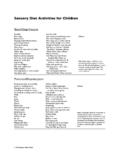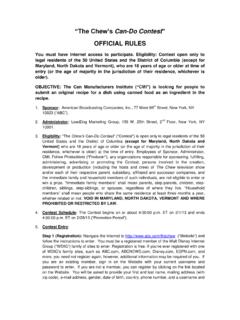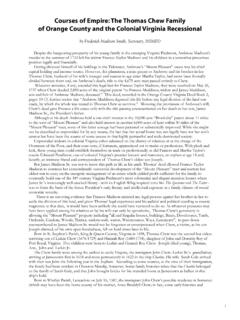Transcription of Biters, Chewers, Suckers, and Pickers - SensorySmarts
1 Dear Mom,Humans are oral creatures. Babies !rst explore toys, !ngers, and other objects with their mouths. "en they start to use their eyes, hands, and other body parts to check out their world. We all con-tinue to self-soothe orally to some degree throughout the lifespan, but usually in socially acceptable ways such as chewing gum, snacking even when we re not hungry, and so signi!cant number of children with sensory processing challenges engage in mouthing beyond the age people typically stop doing so. Before considering whether this is due to a sensory processing issue, it s essential to address any physical or emotional factors such as:t Pain. Is there a dental issue such as a misaligned bite or a toothache? Does your child grind her teeth? Is there jaw clenching, tightness, popping, or clicking? An earache? "ese may be signs of TMJ Pica. "is is a psychiatric condition in which a person eats non-food items such as clay, sand, dirt, feces, pencils, paper or other non-nutritive items.
2 It is seen in small children, We self-soothe orally to some degree, but usually in socially acceptable ways. Biters, chewers , Suckers, and PickersLindsey Biel, OTR/Lsensory | sensory smartspregnant women, and people with developmental disabilities. t Anger, Frustration, or Anxiety. Is the behavior in response to not being able to communicate her needs and wants or not having her desires met? Is it a sign that she is anxious about something?t Hunger. Does she need to eat something? Does a particular food irritate her digestive system?t Bored. Idle hands and mouths can lead to !dgety behaviors. Plus this is a good way to get attention!To help with your detective work on this, keep a behavior log noting date, time, the conditions in which the behav-ior occurred, and anything else you think may have contributed ( , didn t sleep well, didn t eat well, had a !ght with a sibling).
3 Let s assume the biting, sucking, and chewing are purely sensory. By now you know that your stop! directive isn t very e#ective. And if you do manage to take away a self-stimulatory behavior like this one, another one usually crops up in its place. From a sensory standpoint, these behaviors provide a lot of tactile (touch) input from skin surfaces and DEAR SENSORY SMARTS,My lovely 8-year-old daughter likes to bite and suck on the strangest things pencils, toys, dress hems, books or whatever. She recently began to chew on her !ngernails and cuticles until they are red and raw. I try telling her to stop but she can t seem to help herself. Any suggestions?From, Mother of Mouthy Girl 40 September October 2011 ! Autism Asperger s Digest"ese and many other items can found in therapy catalogs and at > toys & equipment>oral comforts. Sometimes kids nibble or pick at their cuticles as a sensory behavior and sometimes as a nervous habit.
4 It might help to tell your child that this communicates that you are nervous to oth-ers who can see what you are doing. You can teach her to put her hands in her lap, in her pockets, under her thighs, or pro-vide her with a !dget toy such as a Tangle Jr., Rubik s Cube, or a worry stone. Some parents take their daughters for manicures that nip away jagged, bitable cuticles every week or so. It s an added expense, but the girls take great pride in their pretty nails and cuticles and it becomes a special parent-daughter time that both enjoy. Boys enjoy manicures too, though you may want to skip the polish. You can also do manicures yourself. Take cau-tion with cuticle nippers because it s so easy to nip the skin. Try cuticle removing solution and an orange stick instead if you go the do-it-yourself route. You can help your child get needed sensory input into her !n-gers by !rmly squeezing the nail bed and !
5 Ngertip (you can teach her how to do this) and helping her explore di#erent kinds of substances with her !ngers, by using playdough and clay, digging in the dirt while gardening, helping to cook dinner by mixing items with her hands, and so on. Habitual nose picking, usually a !dgety self-soothing behavior, is socially unacceptable and unhygienic. At home, use a nasal wash (Simply Saline or Little Noses Saline Nose Spray) to thin mucus, soothe nasal passageways, and help him recognize that he has an issue with this. While no one wants a child to become self-conscious, the !rst step in overcoming any habit is to become aware of it. When you see the behavior, unemotion-ally observe that your child is doing it because he may not even realize it, , Oh, you are picking your nose. Explain that the behavior turns o# kids and adults, and that if he needs to clean out his nose he should do it privately in the bathroom and then wash his hands.
6 When a child picks his nose publicly, make neutral (not angry or judgmental) eye contact and use your neutral verbal cue or use a pre-arranged hand signal such as touching the tip of your nose. "en your child should go wash his hands with soap and water or use antibacterial gel to disinfect his hands. Assuming it is a self-soothing habit, it is essential to give him something more appropriate and hygienic as a substitute, such as a hand !dget. Be sure to share your strat-egies with your child s teacher, grandparents, therapists, and others. For more on oral comforts, self-soothing, and the sensory behavior connection please see Raising a Sensory Smart Child and visit proprioceptive (body awareness from joints, muscles, and con-nective tissue) from the jaw and teeth. What you want to do is to meet the underlying sensory need in a more acceptable, hygienic way through substitution and/or with your occupational therapist or speech language pathologist about an oral sensitization program.
7 "is might include providing deep pressure to the mouth, including the cheeks, lips, gums, teeth, and jaw. "e therapist might also rec-ommend ice chips and vibration using a Z-vibe and/or a vibrat-ing toothbrush. Whistles and blow toys can also be helpful at normalizing oral foods also provide useful sensory input. Crunchy foods like carrot sticks, pretzels and freeze dried vegetables provide great input to the teeth and jaws. Chewy foods like bagels and fruit leather are great too."ere are a number of wonderful oral comfort items that a child can learn to use which are safer, cleaner, and more socially acceptable. Here are some of my favorites:t Chewing gum. Try Glee Gum, which is gluten-free and casein-free, and Spry gum which contains Xylitol, a natural sweetenert Liquids. Plain !ltered water is great as is organic coconut water. Avoid drinks loaded with sugar and arti!
8 Cial col-ors and sweeteners. Drink liquids, especially thicker ones, through fun straws. t Non-toxic, latex-free, lead-free, phthalate-free chewies: t ChewEase. A clear plastic tube connected to a cord and clip to attach to a belt loop or clothingt ChewEase Pencil Topper. Just the tube which !ts nicely over a pencil t Kids Companions. Chewable hearts or circles in vari-ous colors that can be worn as a necklace, attached to clothing. or used as a zipper pullt Chewlery. Stretchable, chewable bracelets (preferred for safety) and necklaces t Chewy Tubes, Ark s Grabber, P s & Q st chew Stixx and Pencil Topper chew Stixx. Especially durablet chew Noodle. A long colorful tube that is strong and stretchable with a carabiner to attach to shirt or belt loopt Dr. Bloom s Chewable Jewels. "ese necklace charms and bangles were invented by a dentist. Nice for parents to wear or for kids to wear with safety precautions such as a quick release knot.
9 T Retractable Bite Buddies. Loads of fun, colorful shapes to pick from with a retractable belt clip ! September October 201141











